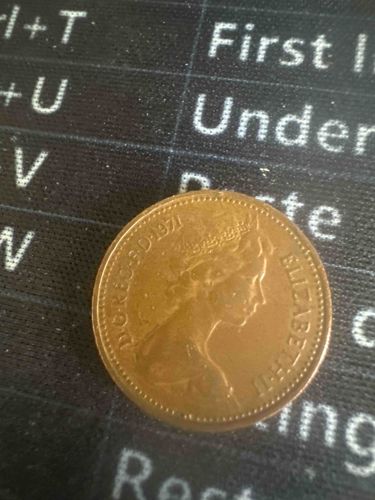
British One Penny Coin (1971)
The item is a circular, metallic coin, appearing to be made of a bronze or copper alloy, given its distinct reddish-brown coloration. The obverse side, which is visible, features a right-facing portrait of Queen Elizabeth II, depicting her in a a tiara or crown. The design of her effigy is consistent with the 'Second Portrait' (also known as the 'Machin Portrait') by Arnold Machin, commonly used on British coinage from 1968 to 1984. Surrounding the portrait, along the coin's rim, there is a legend that reads 'D.G.REG.FD:1971 ELIZABETH .' The specific date '1971' is clearly visible, dating the coin to that year. The coin exhibits a well-worn surface consistent with circulation, displaying a somewhat dull luster and areas where the original metal is exposed due to wear, particularly on the raised features of the portrait and lettering. There are no significant signs of major damage such as deep scratches, bends, or deliberate alterations, but typical circulation marks like minor abrasions are present. The edges appear reeded, though this is not perfectly clear in the image. The overall craftsmanship suggests a standard minting process for circulated currency.
AI-Generated Appraisal Disclaimer
Estimated Value
$0.05 - $0.25
Basic Information
Category
Coin
Appraised On
November 28, 2025
Estimated Value
$0.05 - $0.25
Item Description
The item is a circular, metallic coin, appearing to be made of a bronze or copper alloy, given its distinct reddish-brown coloration. The obverse side, which is visible, features a right-facing portrait of Queen Elizabeth II, depicting her in a a tiara or crown. The design of her effigy is consistent with the 'Second Portrait' (also known as the 'Machin Portrait') by Arnold Machin, commonly used on British coinage from 1968 to 1984. Surrounding the portrait, along the coin's rim, there is a legend that reads 'D.G.REG.FD:1971 ELIZABETH .' The specific date '1971' is clearly visible, dating the coin to that year. The coin exhibits a well-worn surface consistent with circulation, displaying a somewhat dull luster and areas where the original metal is exposed due to wear, particularly on the raised features of the portrait and lettering. There are no significant signs of major damage such as deep scratches, bends, or deliberate alterations, but typical circulation marks like minor abrasions are present. The edges appear reeded, though this is not perfectly clear in the image. The overall craftsmanship suggests a standard minting process for circulated currency.
Related Tags
Get Your Items Appraised
Instant estimates of your treasures with AI-powered instant appraisals